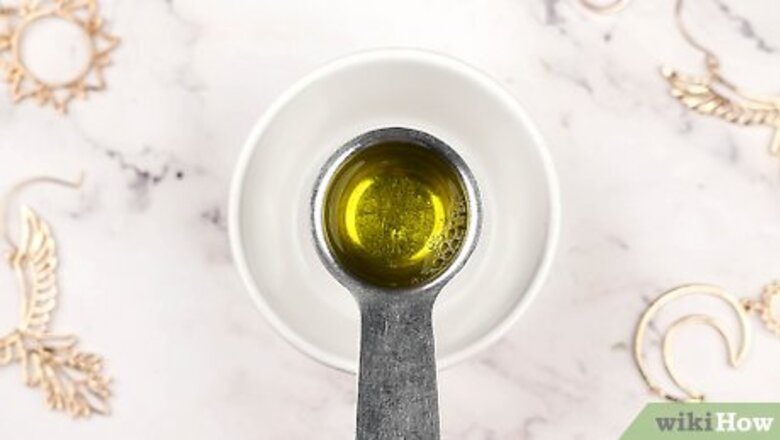
views
Using Mild Dish Soap
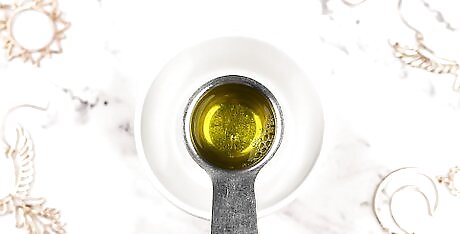
Use dish soap to clean delicate jewelry. This method is the gentlest way to clean gold. If the gold is a very soft 18- or 24-karat gold, it may be scratched by other methods. However, the cleaning agents in the dish soap may loosen gemstones, diamonds, and other set stones. If you think a stone may be coming loose on your jewelry, take it to a jeweler to be reset. Otherwise it may fall out and get lost.
Create the cleaning agent. Pour about a tablespoon of dish soap into a dry glass bowl. Adding the soap before the water will help the dish soap mix in evenly. Next, fill the bowl with water. The water should be hot, but not so hot that you can’t touch it. If you’re cleaning gold jewelry set with pearls, add a few drops of baby oil to the cleaning mixture. This will help protect the pearls from damage.
Soak and wash the gold. Let the gold soak in the soapy water for about fifteen minutes before scrubbing it to loosen oils and grime. If you’re cleaning jewelry with pearls, stones, or settings, skip the soaking and immediately start cleaning the jewelry. Clean the gold by scrubbing it with a clean, soft bristled toothbrush. Take care not to scratch the surface. If you don’t want to use a toothbrush, you can also use an eyebrow brush or a brush made specifically for cleaning jewelry. Use a new toothbrush when cleaning jewelry. Old toothbrushes may have toothpaste residue that will scratch the gold.
Rinse the gold under warm tap water. Rinse the gold over a strainer or glass bowl to prevent it from washing down the drain. Alternatively, plug your sink to while rinsing to avoid losing jewelry. Rinse the jewelry thoroughly to remove all the detergent. Dried detergent residue can leave an unattractive film on gold. Cover the drain with a piece of paper towel so your jewelry doesn't fall into it in case you drop it.
Cleaning with Baking Soda and Vinegar
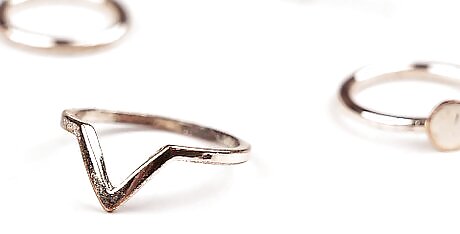
Use this method to clean hardy 14-karat jewelry or gold coins. This technique is not as gentle as using soap and water. However, the cleaning agents in the baking soda and the acid from the vinegar will quickly clear any grime from metal. Avoid using this technique on jewelry with stones, pearls, or settings. The vinegar and baking soda may loosen the settings and damage the jewelry.
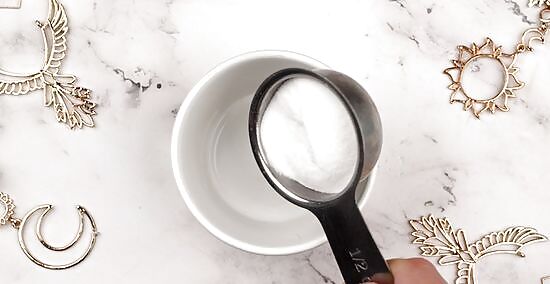
Create your cleaning mixture. Mix ¼ cup baking soda with 2 tablespoons of warm water in a glass bowl. Stir the mixture together to make a thick paste. If the mixture is too runny, sprinkle in some baking soda. If it’s too thick, add a few more drops of water.
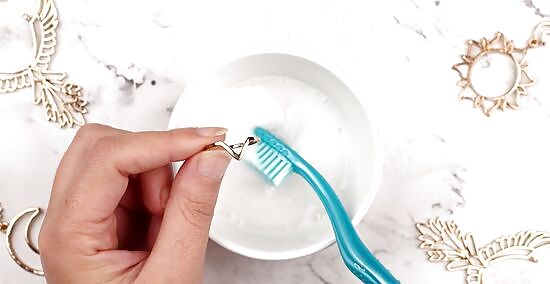
Rub the paste on your gold. Use a sponge, soft cloth, or soft toothbrush to transfer the baking soda paste to the gold. Gently rub the mixture into the surface of the gold, taking care to reach all the nooks and crannies. However, be careful not to scratch the gold with the toothbrush.
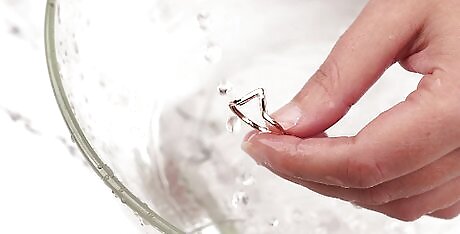
Rinse the gold. First, rinse the gold with vinegar. Any kind of white cooking vinegar will work. If you work over a sink, rinse the gold in a sieve or plug the sink to avoid losing the gold down the drain. Next, thoroughly rinse the gold with warm tap water to wash away the vinegar. If you’re cleaning gold with gemstones, pearls, or settings, like a ring or earrings, skip the vinegar and rinse the baking soda off with warm water.
Washing Gold with Ammonia
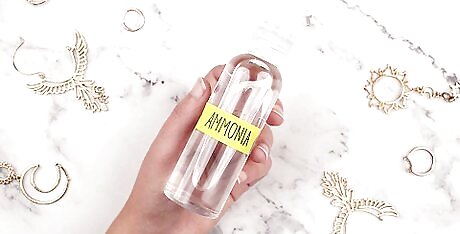
Try using ammonia to clean large, grimy pieces of gold. Ammonia is a very powerful cleaner and can remove the most stubborn greasy gunk from gold. This technique will also clean diamonds that are set into the gold. However, use this method sparingly. Ammonia can discolor and corrode metal over time. Ammonia can damage almost all gemstones, pearls, and stones. Diamonds are the exception.
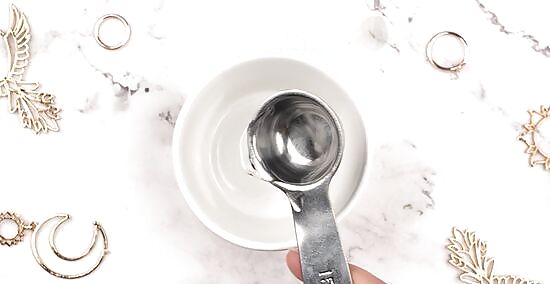
Mix your cleaning solution. Add six parts water and one part ammonia to a glass bowl or cup. For example, if you use six tablespoons of water, add one tablespoon of ammonia. Use enough liquid that the gold will be completely submerged in the bowl or cup.

Soak the gold in the ammonia solution. Let the gold soak for up to 60 seconds. If you let it soak too long, the ammonia may damage or discolor gold. If you see any hardened debris, gently wipe the gold with a soft cloth after removing it from the ammonia. Handle the freshly cleaned gold with care to avoid scratching it.
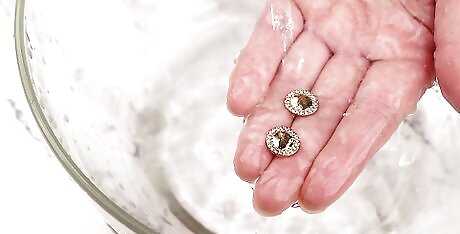
Rinse the gold with warm water. Use a sieve when rinsing the gold or plug up your sink. Otherwise, you may lose your gold down the drain. Make sure to thoroughly rinse away the ammonia. Any ammonia left on the surface of the metal will continue to corrode the metal.
Adding Finishing Touches
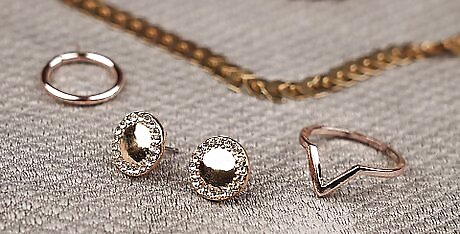
Dry the clean gold. Let the gold air dry overnight in a secure spot. Alternatively, buff the clean gold dry for immediate use. Use a soft, dry polishing cloth, a fresh microfiber towel, or a scrap piece of cotton fabric. The softer the fabric, the less likely it is that the gold will be scratched. If you let the gold air dry, store it in a spot that doesn’t see a lot of activity. Otherwise, the gold may be knocked off its perch and lost. Buff air-dried gold with a soft towel to make it shine.
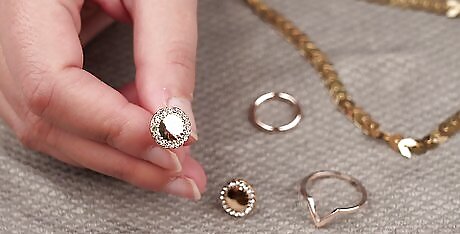
Inspect jewelry for loose gemstones. Once the jewelry is clean and dry, carefully inspect any gemstones or settings. To do so, gently wiggle the stone with your finger. If anything has come loose, immediately take it to a jeweler for repair. Otherwise, the stone may fall out and get lost. Place the jewelry in a plastic sealable bag while traveling to the jeweler. If the stone falls out, it will stay in the bag.
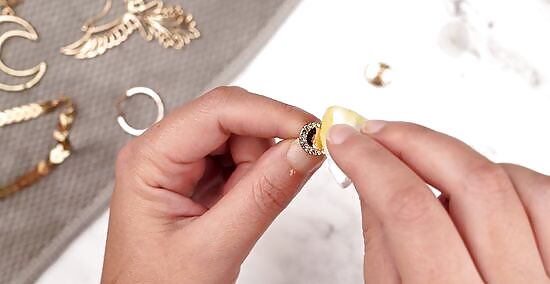
Clean any gemstones or pearls. Clean a pearl by buffing the surface with a soft cloth dotted with olive oil. Avoid using detergents on pearls as this can cause discoloration. Similarly, clean gemstones with a wet cotton cloth and buff them with a soft, dry cloth until they shine. If your gemstones are especially dirty, see a professional jeweler. They may have to sand the gemstone to clean it properly.


















Comments
0 comment